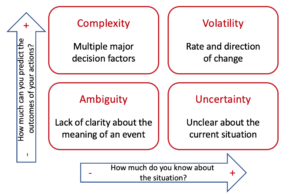18 Apr Leadership in a (prolonged) crisis
Leadership in a (prolonged) crisis refers not only to the coronavirus pandemic; it also focusses attention on coping with the crises that occur in our everyday professional and personal lives.
Key concept
The environment in which big – and small – crises occur has been famously described as VUCA – volatile, uncertain, complex and ambiguous. VUCA expresses the fact that the rate of change in a crisis situation outpaces our ability to adapt. This gap means we have to rethink how we lead ourselves, others and our organisations.
 Old leadership ways need to give way to newer mental models based on agile decision-making, people-orientation, critical thinking, adaptable learning and responsiveness to change.
Old leadership ways need to give way to newer mental models based on agile decision-making, people-orientation, critical thinking, adaptable learning and responsiveness to change.
Crisis leadership has two distinct phases. The first is the emergency phase when the tasks are to stabilise the situation and buy time. The adaptive phase follows during which the tasks are to tackle the underlying causes, learn to (try to) prevent recurrence and build capacity to thrive in the post-crisis world, now being termed the ‘other side’ (of the pandemic).
As a leader in the adaptive phase, people look to you to respond to their anxieties and provide authoritative guidance, even if at times you over-sell what you know and discount what you don’t. As your people cry out for direction, you face decisions about the way forward that is VUCA.
An adaptive leader does not relax and return to BAU when the emergency is over. Rather, the adaptive leader presses the re-set button, brings closure to the past and in doing so changes the rules of the game, reshapes their organisation and redefines the work people do. Here are four ways to do this.
Applying the concept
- Foster adaption. Confront loyalty to legacy practices. Ban ‘this is what we have always done in these situations’ laments. Be a role model for flexible and divergent thinking. Distinguish between the essential and the nice to keep. Decide what’s mission-critical and review everything else. Fostering adaptation requires careful risk management; adopt a portfolio approach by placing multiple bets in the knowledge that some will fail.
- Welcome instability. Deliberately strike a balance between the same-old and chaos. Not enough change will demoralise people, too much will cause fright, freeze or flee behaviours. Stop seeking permanent solutions, nothing is permanent any more, the sand shifts all the time. Don’t try to suppress conflict, rather depersonalise the issues by creating courageous conversations where people feel safe while disagreeing with each other.
- Nurture leaders. Find fresh perspectives by engaging and empowering many levels in the organisation. Constantly remind yourself that wisdom and ingenuity are found everywhere, not only in the executive suite. Foster inter-dependence and celebrate collaborative leaders. Replace hierarchy with organisation-wide bandwidth. COVID isolation is the perfect opportunity to learn this.
- Care for yourself. If you are to succeed in practising McKinsey’s ‘deliberate calm with bounded optimism’, you must care for yourself physically and emotionally.
This post draws inspiration from Leadership in a (Permanent) Crisis published in Harvard Business Review in 2009, reflecting on the GFC of those times.
In a series of HBR in 2010-2011 blogs late US Army Colonel Eric Kail outlined adaptive leadership for operating in a VUCA world. His advice has been converted to apply to all types and sizes organisations.


